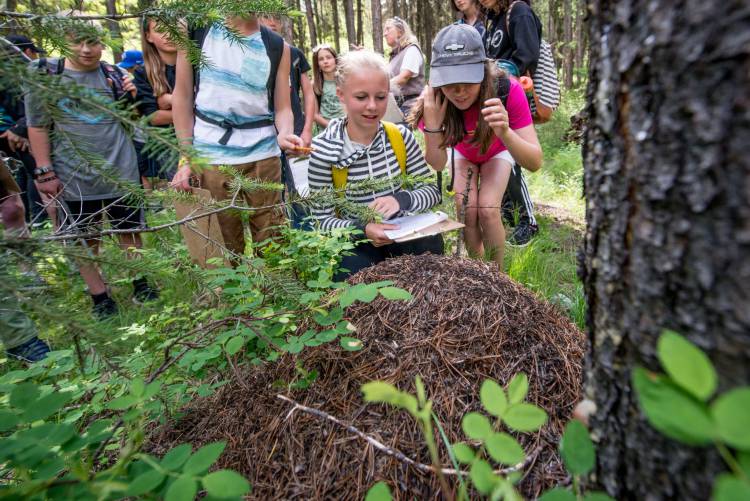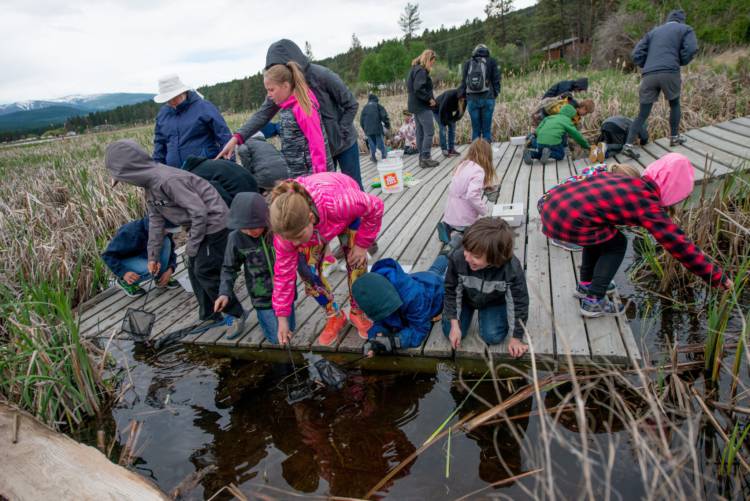This school year, more than 2000 Grade 4-7 students from around the Columbia Basin put their pencils in their pockets and marched deep into the wild world of their own backyards with our Classroom With Outdoors program. As the name suggests, students stepped away from their desks and headed outside on day-long field trips to their local wetlands, forests or grasslands. Taking the learning outside makes the lessons they learn real for young minds in ways that a textbook never will.
“When the class heads outdoors, students immerse themselves in the natural world and learn to interpret the complex systems of life in their local environment, in line with the new BC curriculum,” says Monica Nissen, Wildsight’s Education Manager. “These powerful lessons tend to stick, because they are hands-on and fun.”
Students in five communities took their environmental education one step further with our EcoStewards program, taking on their own stewardship project to protect or share knowledge about their own special place. In Creston students took on ecological planning for their schoolyard, conserving water, building up soil fertility and mimicking natural systems, all while growing healthy food like potatoes, rhubarb, strawberries and raspberries in their schoolyard garden. Meanwhile, in Kimberley, students became stewards of the local Nature Park, learning to identify invasive plants and clearing an infested area.
Further east, students in Balfour created a field guide to the plants and trees near their school, consulting with a local botanist, biologist and ecologist for their research. They classified the plants and learned about traditional uses, edibility and medicinal qualities, ecological niches and more, summarizing their learnings in an illustrated guide with the help of a local artist.

Rossland students, embracing the maxim that the best way to learn is by teaching, joined up with students from Castlegar and Trail to teach each other about the ecology of their own special place. At Strawberry Lake, the Rossland students welcomed the other students to a series of educational stations covering wolverines, water, identification of different ungulate prints, benthic macroinvertebrates including the caddisfly and First Nations’ perspectives. And up north in Revelstoke, students planted 200 native plants along the Illecillewaet River to prevent erosion on a disturbed site at the foot of a bridge.
“I love teaching Wildsight programs like EcoStewards,” says Revelstoke educator Janette Vickers. “These programs really connect students to their community in ways they often have not realized were possible,” Janette adds. “I especially enjoyed watching the little moments where the students momentarily became the teachers, like when they would explain the value of this stewardship project to their community neighbours.”
Classroom with Outdoors takes students from Grade 4 to Grade 7 out into their natural surrounding to experience the intricacies of their ecosystems first hand. Grade 4 students focus on the magic found in nature, learning new ideas like ecosystems and photosynthesis, and how living things respond to their environment, in a fun and enchanting way. For the Grade 5s, it’s all about the web of life and the complex interconnections between producers, consumers and decomposers and how materials from the Earth can be used as natural resources. Grade 6 students explore their local ecosystem through the eyes of a travelling alien scientist, learning about the biological systems within living things. And in Grade 7, students investigate ecological principles, the diversity of life and learn valuable lessons from a teacher ever wiser and older than their own teacher—mother nature herself!
“Wildsight would like to thank all the teachers, schools, volunteers and funders that make Classroom With Outdoors possible,” adds Nissen, “including the Columbia Basin Trust, Columbia Power Corporation, BC Gaming, Fortis BC, Teck Coal and the Canadian Museum of Nature, Teck Trail, and the Osprey Foundation.”

Photos, top to bottom, by: Michael Royle, Julie-Anne Davies, J-A, Janette Vickers, J-A




